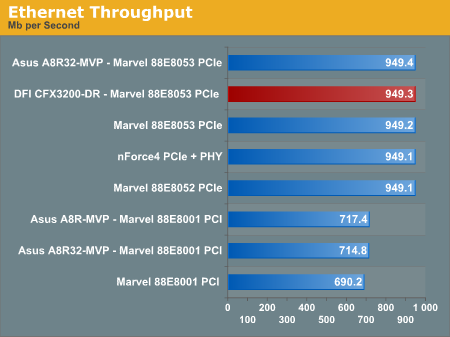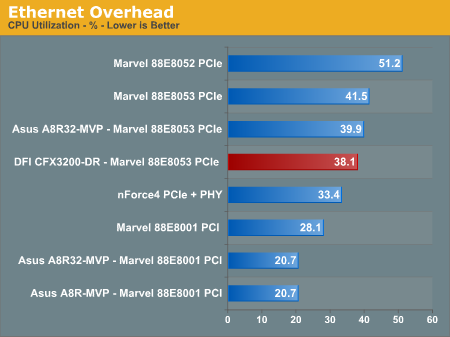DFI CFX3200-DR: ATI RD580 Tweak Attack
by Wesley Fink on May 8, 2006 12:05 AM EST- Posted in
- Motherboards
Network
The Windows 2000 Driver Development Kit (DDK) includes a useful LAN testing utility called NTttcp. We used the NTttcp tool to test Ethernet throughput and the CPU utilization of the various Ethernet controllers used on the AMD motherboards.We set up one machine as the server; in this case, an Intel box with an Intel CSA Gigabit LAN connection. Intel CSA has a reputation for providing fast throughput and this seemed a reasonable choice to serve our Gigabit LAN clients. At the server side, we used the following Command Line as suggested by the VIA whitepaper on LAN testing:
Ntttcps -m 4,0,‹client IP› -a 4 -l 256000 -n 30000
On the client side (the motherboard under test), we used the following Command Line:Ntttcpr -m 4,0,‹server IP› -a 4 -l 256000 -n 30000
At the conclusion of the test, we captured the throughput and CPU utilization figures from the client screen.

As you can clearly see the PCIe Gigabit LAN on the DFI is capable of about 35% faster speed than the performance we have measured with PCI Gigabit LAN used on some competing motherboards. DFI provides a pair of Marvell PCIe Gigabit controllers which should satisfy most end users. All of the on-board PCIe Ethernet controllers seem to exhibit high CPU utilization, but you should keep in mind that the CPU usage we measure is an extremely artificial number which measures the worst case of a continuous 1Gb transmission. With broad-band connections needing less than 100Mb Ethernet, the real-world CPU usage will be much lower than these test results.
USB and Firewire Performance
USB has been a problem area for the ATI SB450 chipset, but it has not been a major issue with the ULi M1575 Southbridge. To test performance of USB and Firewire on the DFI CFX3200-DR we ran our standard USB throughput test using an external USB hard drive. For Firewire tests an external Firewire 400 or 800 hard disk is used for testing. Our test method uses a RAM disk as our "server" since memory removes almost all overhead from the serving end. We also turn off disk caching on the USB and Firewire side by setting up the drives for "quick disconnect". Our results are then consistent over many test runs.We use just 1GB of fast 2-2-2 system memory, set up as a 450MB RAM disk and 550MB of system memory. Our stock file is the SPECviewPerf 8.01 install file which is 432,533,504 bytes (412.4961MB). After copying this file to our RAM disk, we measure the time for writing from the RAM disk to our external USB 2.0 or Firewire 400 or Firewire 800 drive using a Windows timing program written for AnandTech by Jason Clark. The copy times in seconds are then converted into Megabits per second (Mb) to provide a convenient means of comparing throughput. Higher Rates therefore mean better performance. Blue bars represent USB 2.0 performance, while green bars represent Firewire.

The DFI CFX3200-DR performed virtually the same in USB tests as we have measured in other recent tests of the ULi M1575. While USB performance is a bit slower than NVIDIA, it is definitely competitive with the NVIDIA results, with throughput about double the ATI SB450. This is a big improvement and the reason ASUS, ECS, MSI, Abit, and DFI are using ULi M1575 instead. This will likely change with the introduction of the updated ATI SB600, which is expected with the launch of ATI chipset motherboards for AM2.
DFI chose the excellent VIA VT6307 to power the IEEE1394 ports on the CFX3200-DR. The VIA has been tested as fastest Firewire 400 in past results - running neck and neck with the Agere Firewire chip. Performance is where we would expect for the VIA Firewire chip.










25 Comments
View All Comments
poohbear - Monday, May 8, 2006 - link
nice mobo and all, but is it really worth $240 usd?! i think that money would be better spent on a decent mobo and the savings on a better vid card.:/cornfedone - Monday, May 8, 2006 - link
WAY too expensive and no tangible performance increase over RD480 mobos.The mobo companies are out to pork consumers with sky high prices for commodity mobos. The RD480/RD580 chipsets are pretty low cost chipsets and the mobo designs less than stellar to say the least. For that Asus, DFI, Sapphire et al are asking outrageous prices for mobos with long lists of problems. None of these mobo companies has delivered a properly functioning mobo, they provide no tech support and they don't listen to their customers. All they do is use the hardware review sites as PIMPS to SHILL products that aren't ready for Prime Time.
With no serial port, only one usable PCI slot, a $200+ price tag, Mickey Mouse board layout design, too many BIOS adjustments that have little or no benefit, lack of quality tech and customer support, etc. the DFI mobo can sit on the shelf until Hell freezes over as far as I am concerned. Anyone willing to pay $200 for a malfunctioning mobo deserves exactly what they get or don't get.
PT Barnum is still alive and flourishing in the mobo industry.
Marlowe - Monday, May 8, 2006 - link
I think the Sapphire PURE Crossfire A9RD580 suffers from the same problems as you mention. Just too many settings in bios to master. I expect you don't have the time to test this motherboard as well? I've actively worked with it to or from in three weeks now.. without even getting the HTT over 290 and get my ram to work at 2,5-3-3 settings :P Also in contrast to DFI, Sapphire has very poor bios and software support :)I might just be a n00b tho! But one should think almost a month of focus should be enough to get a computer working..
Peter - Monday, May 8, 2006 - link
And yet again, we are seeing RAM performance attributed to the chipset - on an AMD64 chipset. Page 5 says:"Optimum tRAS
In past reviews, memory bandwidth tests established that a tRAS setting of 11 or 12 was generally best for nForce2, a tRAS of 10 was optimal for the nForce3 chipset, a tRAS of 7 was optimal for the nForce4/ATI RD480/ULi M1697 chipsets, and a tRAS of 10 produced the best bandwidth on the ULi 1695. The ASUS A8R32-MVP review established that a tRAS setting of 8 produced the highest bandwidth on the RD580 chipset."
Hello? As has been pointed out numerous times with those articles (every time, in fact), and as you certainly know, chipsets on AMD64 platforms do not even connect to the RAM. The CPU does that. Paragraphs like the above quoted are just plain nonsense.
Dear reviewers, are we being thick or are we just stuck too deeply in cut&paste land? You've been dragging this silly mistake along for three years now.
regards,
Peter
JarredWalton - Monday, May 8, 2006 - link
The CPU does indeed house the memory controller, but that doesn't mean the chipset doesn't have an impact on memory timings. The point is that tRAS was tested at varying levels to determine an optimal settings. While nF4, Rx480, and M1697 got best results with tRAS set to 7, M1695 liked 10 and RD580 appears to do best with ~8. Realistically, the difference between tRAS 5 and tRAS 10 in actual applications (i.e. not memory benchmarks) is going to be less than 1 or 2%. However, it's good to be clear that we're using 2-2-2-8-1T timings because those appear to be better overall than 2-2-2-5-1T.Calin - Monday, May 8, 2006 - link
While the memory controller is on the processor (and have very little in common with the chipset), one must note that the chipset will access the memory with different purposes, like DMA (Direct Memory) access from hard drive controllers, or integrated video chipsets needs a lot of bandwidth to the memory. In this, the processor is "left outside" the transfer, and the memory controller on the processor does the copy job.I don't know why different chipsets will favour different tRAS values, but the chipset needs to access the memory controller without intervention from processor
Visual - Monday, May 8, 2006 - link
so this board has drive strength settings for everything and their mother... but is that needed? is it ever useful?if they all default to max anyway, what good is the ability to set it at 31 lower settings?
and its porbably the same with many other options - if they're set to the right value already and have a warning "do not change or your system will puke" in the comments, why do we even have those options?
Calin - Monday, May 8, 2006 - link
Maybe when set at the max value, they create "echo" in other nearby lines (disrupting other signals)JarredWalton - Monday, May 8, 2006 - link
Reaching maximum overclocks - just like fine tuning a typical BIOS - requires a lot of tweaks. Getting top performance from every memory type available using "Auto" settings is not likely to happen. You can discover through trial and error where the "sweet spot" is for your particular RAM, and you might find that it gives you and extra 100-200 MHz.For example, memory skew is mostly (as I understand it) a way of increasing stability. You tweak the memory so that signals are read/sent slightly out of phase with "default", and that can be used to compensate for higher clock speeds. You would end up adjusting skew at various overclock levels to maximize stability. Drive strength is another option for tuning the system to work optimally with your RAM and CPU at various speeds; higher voltages and clock speeds would respond differently to varying drive strengths.
The problem is, finding the optimal values for even one configuration is a trial and error process that can literally take weeks or even months. Do most people need that or even want that? Probably not. For the few that do, they'll probably love this board. That's why Wes says it would be nice to hide the less frequently used options and give them reasonable "Auto" settings. In the extreme, choosing even drive strength and DQS skew while leaving all other settings the same represents 16,744,448 potential settings (three separate drive strengths with 32 potential settings, and 511 skew settings).
The good news is that there are people out there with a better understanding of the low level details that are writing guides to help others optimize performance without testing every setting.
Clauzii - Monday, May 8, 2006 - link
It looks like CrossFire is becoming a potent and competitive subject, despite what a lot of people said a year ago, and with this board from DFI, it looks like the future is indeed bright for people who want´s ATI Crossfire or thought they didn´t.It also looks that DFI has indeed become a star in the motherboard market - especially when the outdated SATA chips get a trip to the eternal outer space silicon fields - and gets an 600 injection.
To me it also seems that these boards must be near rocksolid, since I don´t see any mentions of strange behavior - nice.
Crossfire software (CCC and the horror that belongs to it!) needs to be solved by ATI as soon as possible!! as it looks to be the only thing holding back on more people getting it.
Thanks for a Nice and pretty well written article :)